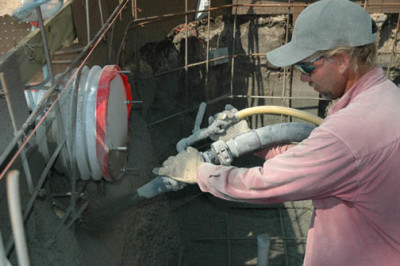Pumps and placement
To produce a wide swimmable stream of water, one must first determine the proper pump size. Most systems on the market today incorporate a pump hydraulically designed to produce the proper amount of flow through the nozzle, resulting in a smooth stream of water. Mixing and matching different pumps with different nozzles may not result in the swim experience the customer is expecting. Installers must ensure the pump has been designed for the entire swim system.
An advantage of a swim jet system is that the pumps and jets are independent of the circulation pump and can be turned on and off at will. Swim jet pumps are very similar to standard swimming pool pumps, but are designed to match the flow requirements of the nozzles. Given these similarities, pump maintenance is easy and straightforward. Any properly trained pool and spa pump service person can maintain a swim system; there is no need for specialized tools or equipment.
Once pump needs are determined, proper placement of the jets is needed to ensure optimum results. In general, it is best to install jets at one end of the pool. A side-wall installation can work, but there must be at least 4.2 m (14 ft) of pool clearance from the jets (or at least twice the length of the swimmer’s body). Jets should be placed in a part of the pool that is no deeper than 1.2 m (4 ft). The centre of the jet nozzle should be about 254 mm (10 in.) below the water surface.
New construction
During the design phase, swim jet placement can be maximized for optimum swimming and pool aesthetics. There are many options for jet placement, quantity, type and colour. In addition, proper plumbing and electrical supply can easily be factored in before construction begins and customer expectations can be more easily managed.
Any size pool or spa is a candidate for swim jets, though some manufacturers suggest a minimum pool width of 2.1 m (7 ft), length of 4.2 m (14 ft) and depth of 1.1 m (3.5 ft) to allow sufficient swimming space. The extra length allows the swimmer to comfortably drift back and swim upstream. Of course, builders should always consult local codes for minimum distance between the system pump and pool.

On some systems, when the distance between the jet housing and pump is 9.1 m (30 ft) or less, it is recommended to use 101-mm (4-in.) pipe. On runs longer than 9.1 m, 152-mm (6-in.) pipe is recommended. Proper pipe size allows for the right amount of flow based on the swim jet design.
An air regulator is included with most swim jet systems, enabling the swimmer to boost the amount of air in the swim current. More air in the stream can provide more resistance. The air regulator can be installed anywhere, as long as it is not continuously flooded with water.
Once planning and preparation are complete, a swim system with one, two or three jets should take about a day to install. The jet housing should be encased with gunite; at least 50 to 76 mm (2 to 3 in.) of plumbing stub out should also be covered with gunite.
Swim jets can be easily installed in a liner or fibreglass pool. The installation process is similar to the gunite process. After completing a cutout in the pool, the swim jets are mounted and screwed into the pool wall. Plumbing and electrical details are similar to a gunite installation. In addition, some systems have the ability to tie into automated pool and spa control systems.






